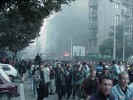How NATO propaganda misled the public
The alleged existence of plans for an "Operation Horseshoe" was a crucial
element of NATO's war propaganda. Whenever someone pointed to the obvious fact that the
NATO war had precipitated the mass flight of Albanians from Kosovo, rather then preventing
it, the person was referred to "Operation Horseshoe". According to NATO
officials, this was a detailed plan worked out by the Milosevic regime in 1998 to drive
all or most Albanians out of Kosovo. Even if NATO had not attacked, it was argued, the
Albanians would have been driven out. By initiating the war, NATO at least maintained the
option to bring them back at a later point.
The existence and content of the Horseshoe plan was—like so many other elements of NATO's war propaganda—generally treated as fact by the media. Its content and sources were hardly checked. The only
exception I found was an article published on May 19 by the foreign editor of the German daily Frankfurter Rundschau, Karl Grobe.
Grobe makes clear that the origins, sources and content of the Horseshoe plan are very
mysterious, and that even if such a plan actually existed, it could hardly be interpreted
as a blueprint for the expulsion of the civilian population from Kosovo.
The press was informed about the plan in the third week of the war by
general inspector Hans Peter von Kirchbach, the highest commander of the Bundeswehr, the
German army. Kirchbach refused to give any
information on the sources of the plan, because they were "too sensitive". The news agency AP later quoted "experts" who "thought"
that it was leaked by a deserter or originated from secret service sources.
German defence minister Rudolf Scharping claimed that the plan had been
agreed on by Yugoslav President Slobodan Milosevic and the Yugoslav military leadership in
December 1998. Its main aim was, according to
Sharping, to "smash or neutralise" the Kosovo Liberation Army (KLA) and
to expel the Albanian civilian population from Kosovo.
Again Scharping would not give any details, but it is obvious he was speaking about two entirely different questions. The Yugoslav army was involved in a civil war with the KLA and
had suffered numerous casualties. It was therefore entirely legitimate and, from a
military standpoint, necessary that it work out operational plans how best to deal with
the situation. That these plans included the expulsion of the
civilian population remains, at best, unclear.
According to Grobe, the plan says absolutely nothing
about paramilitary groups, which played a crucial role in all cases where the civilian
population was maltreated. It also says nothing about plans after
the beginning of the war on March 24, i.e., the period when masses of Albanians actually
did leave Kosovo. It contains, Grobe points out, hardly any details at all.
What is left, it seems, is nothing more than a plan to
station Yugoslav troops in the shape of a horseshoe along the border of Kosovo. This makes sense in a war with the KLA, but
hardly amounts to a plan of systematic "ethnic cleansing".
In fact, the plan was not even new.
In October 1998—two months before the Horseshoe plan was allegedly
ratified—French and British papers had already published maps showing the deployment
of Yugoslav troops in the form of a horseshoe along the Kosovan border. This, however, did not prevent 200,000 Albanian refugees from
returning to their homes in Kosovo after US envoy Holbrooke brokered an agreement on the
stationing of OSCE observers in the province. Along with these refugees many KLA activists
returned. This was, according to the German defence ministry, a
matter of great concern for the Yugoslav army and led to the drawing up of the Horseshoe
plan.
But it is also possible that the whole plan was invented
later.


